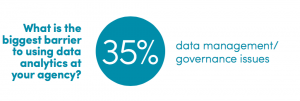This blog post is an excerpt from GovLoop’s recent guide Embracing Data Analytics: Common Challenges & How to Overcome Them. Download the full guide here.
Now that you’ve decided to start a data analytics program, it’s important to consider how the troves of data across your agency will be stored and maintained. Simply identifying your data sources and determining what type of solutions you’d like to pursue is not enough to guarantee your program will be successful.
 When asked what was preventing their organization from beginning an analytics program, one-third of respondents noted that data management challenges were preventing their organization’s progress.
When asked what was preventing their organization from beginning an analytics program, one-third of respondents noted that data management challenges were preventing their organization’s progress.
To ensure that your data can be accurately analyzed, concentrate on building your data management capacities. Below are several areas that require your commitment and focus:
Getting Your Data in Shape
An investment in the right data management tools is just as important as your investment in analytics software. Without properly preserved and refined data, it is exceedingly difficult to turn millions of data points into a meaningful collection. To ensure your data is maintained, you should procure tools to help store and clean your data.
Storage: A key consideration when deciding on a storage solution should be finding an option that enables you to easily access your data, especially if it’s from multiple sources. It can be easy to silo data from different divisions into different repositories, but doing so can make it very difficult to run analytics across all your data. One option is to consolidate data into a single repository that can accommodate everything. A number of agencies have turned to cloud-based storage to make data accessible to multiple stakeholders.
Cleaning: Not all the data you collect will be usable. But inaccurate or incomplete data can get in the way if it isn’t regularly updated or purged from the system. Ideally, your management approach should include tools that are designed to assess the content, consistency and validity of your data. By purging data that isn’t useful, is duplicative or was poorly recorded, analytics programs are more successful. The Office of Unified Shared Services Management, an entity within GSA focused on improving how the government delivers shared services, offered these tips for data cleansing:
- Identify stakeholders involved in data cleansing.
- Establish criteria for clean data.
- Define key milestone dates to implement and maintain the established criteria.
- Develop an approach to categorize data for cleansing and reporting.
Keeping Your Data Safe
The data your agency collects can have a lot of value. Unfortunately, this value can also be a liability and may draw malicious attention. Implementing safety measures to enhance your level of security is critical to protecting your private data from being exposed, stolen or abused. When implementing security measures, it’s important to focus on threats from both outside and inside your agency.
Outsider threats: Thanks to a growing global community of hackers, many agencies are experiencing more cyberattacks than ever. To ensure the integrity of their data, agencies should consider implementing security solutions such as end-to-end encryption. But one challenge is that not all of the partners you share data with may be up to speed with encryption.
“We can have the best [encryption tools and techniques], but if they can’t connect to [the data] and they can’t use the data and they can’t access it, it doesn’t really help me,” said Emery Csulak, Chief Information Security Officer at the Centers for Medicare and Medicaid Services. Csulak recommended working with partners at all levels to help them bolster their security capabilities.
Insider threats: In recent years, the rate of data exposure, both accidental and intentional, by employees has risen substantially. Given the danger of threats from within, it is important to implement measures such as two-factor authentication. Requiring employees to use something that they have and something that they know to access the system helps protect data from undesirable exposure.
Sharing Your Data
Your data and analytics are valuable on their own, but their usefulness can be further amplified when combined with other agencies’ data. But even if agencies are able to establish an agreement to combine their resources, such a venture is unlikely to be successful if their data management approaches don’t permit this collaboration.
Most importantly, your agency should settle on concrete, standard definitions and quality criteria for data. For example, if multiple cities want to compare their data on employment, it is critical to have a clear understanding of what the data means. If each city does not have a standard that regulates how jobs are counted, such as part-time vs. full-time, the data becomes less valuable, as it is difficult to understand and cannot be easily shared.
Data standards are also important for intra-agency data sharing. Fung suggested that agencies start with a few agencies that can gradually adopt standards and work out any kinks, such as data integrity issues. Use of the standard can then be expanded to other agencies.
Most importantly, your team should remember that data management is not solely the responsibility of IT. To successfully manage a new data analytics program, the entire agency must be united behind common goals. With the right data and the right systems for maintenance, your agency can adopt reliable and game-changing solutions.





Leave a Reply
You must be logged in to post a comment.